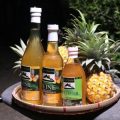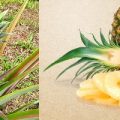The Red Spanish pineapple
In the early 19th century, Western Visayas was a center for fashion for both colonizer and colonized. Piña fiber, which is the raw material used in making barong Tagalog was mainly sourced out from Aklan and brought down south to Iloilo where the fabric was designed and weaved into sophisticated pieces of clothing worn only by the elite. The climate in Aklan and its soil is a sweet spot for the mass production of Red Spanish pineapple whose leaves contain the fiber to make Piña cloth.

The Red Spanish pineapple is the first pineapple variety to flourish in the Philippines. It wasn’t just known for its fiber but locals also grew to love eating its fruit. It eventually lost its appeal when the Hawaiian variety was introduced in the country.
Compared to the Red Spanish variety, Queen Formosa has a larger fruit size by average, and has fruit that’s juicier and sweeter. With the introduction of these newer varieties to the market, Red Spanish production focused on leaf harvesting that supplies for the demand for piña fabric and at the same time overlooked the declining market potential of its fruits.
In March 2017, Agriculture Secretary Emmanuel Piñol visited Western Visayas for his Biyaheng Bukid television program. There, he saw that the pineapple fiber industry is facing an economic slump. “In recent years…the industry has suffered from very low supply of the fiber and the dwindling number of weavers who only earn as much as P300 a day for the difficult work which strains the eyes,” Sec. Piñol mentioned in his Facebook post.
With the Red Spanish pineapple being the only source for piña fiber, Sec. Piñol saw an urgent need to support the industry by providing more quality planting materials and sound protocols that can maximize the growth of Red Spanish, both its leaves and its fruits.
“Yung tanginess ng bunga ng Red Spanish, medyo may kati at parang matabang sabi ng iba, varietal characteristic niya it, ibig-sabihin iyon talaga ang kanyang bunga,” said Mr. Innocencio Obredo, pineapple expert and chair of the Bicol Pineapple Board for the Province of Camarines Norte. When asked about why Red Spanish pineapple no longer appeals to consumer preferences, Obredo mentioned that, “siguro mas lalo siya hindi sumasarap kasi yung practice sa Aklan ay inaalisan ang kanyang mga dahoon bago pa siya maging hinog. So lumalaki ang prutas na walang na siyang ‘lutuan’ ng itinanim.”
Secretary Piñol further instructed the Bureau of Agricultural Research (BAR) and the Bureau of Plant Industry (BPI) to come up with research projects geared towards revitalizing the economic value of the crop.
In response, BAR, as the lead agency for research and development (R&D) in agriculture, immediately convened concerned stakeholders along with its pool of experts, particularly, representatives from the Aklan State University (ASU), DA-Regional Field Office (DA-RFO) 5, DA-RFO 6, and the Philippine Fiber Industry Development Authority (PhilFIDA) to discuss and finalize the R&D component studies to improve the size and quality of the Red Spanish pineapple.
According to BAR Director Nicomedes Eleazar, the group was able to come up with a concept and an action plan showing specific R&D activities to be implemented by concerned agencies specifically on how to improve the fruit size without compromising the quality of its fiber. He added that initial discussion was also facilitated on the issues and concerns of the textile fiber production from the Red Spanish pineapple as this is the main use of the plant.
The R&D component of the program titled, “Fruit Size and Quality Enhancement of Spanish Red Pineapple through Cultural Management Practices,” includes the profiling and marketing research of Red Spanish pineapple production and looking into the cultural management studies for production of large and sweet variety, including cost-benefit analysis of processing products.
The projects that are being conducted by DA RFO 5 and ASU have now plotted Red Spanish pineapple in their own experimental fields. Each plot was treated differently, varying in planting density, leaf harvesting, and fertilizer management.
The initial data results that were collected one year after the project started showed the nuances on leaf sizes depending on the fertilizer management and planting distance. Fertilizer treatments were based on the recommendations of the Bureau of Soils and Water Management and PhilFIDA. ### Ephraim Joseph J. Gestupa
———–
For more information:
Maria Christina F. Campita
Camarines Norte Lowland Rainfed Research Station
Calasgasan, Daet, Camarines Norte
Mobile: +63 09395668973
Email: christina.campita@gmail.com
or
Dr. Lelisa J. Teodosio
College of Agriculture, Forestry, and Environmental Sciences
Tel/Fax: (+036) 267.6780
Source: https://www.bar.gov.ph






